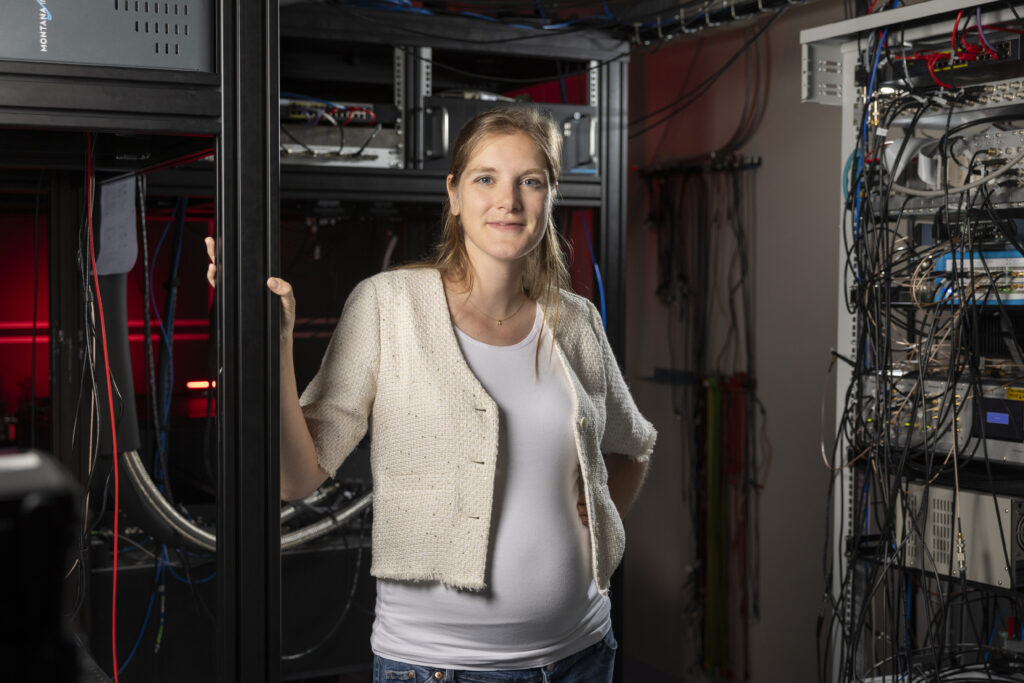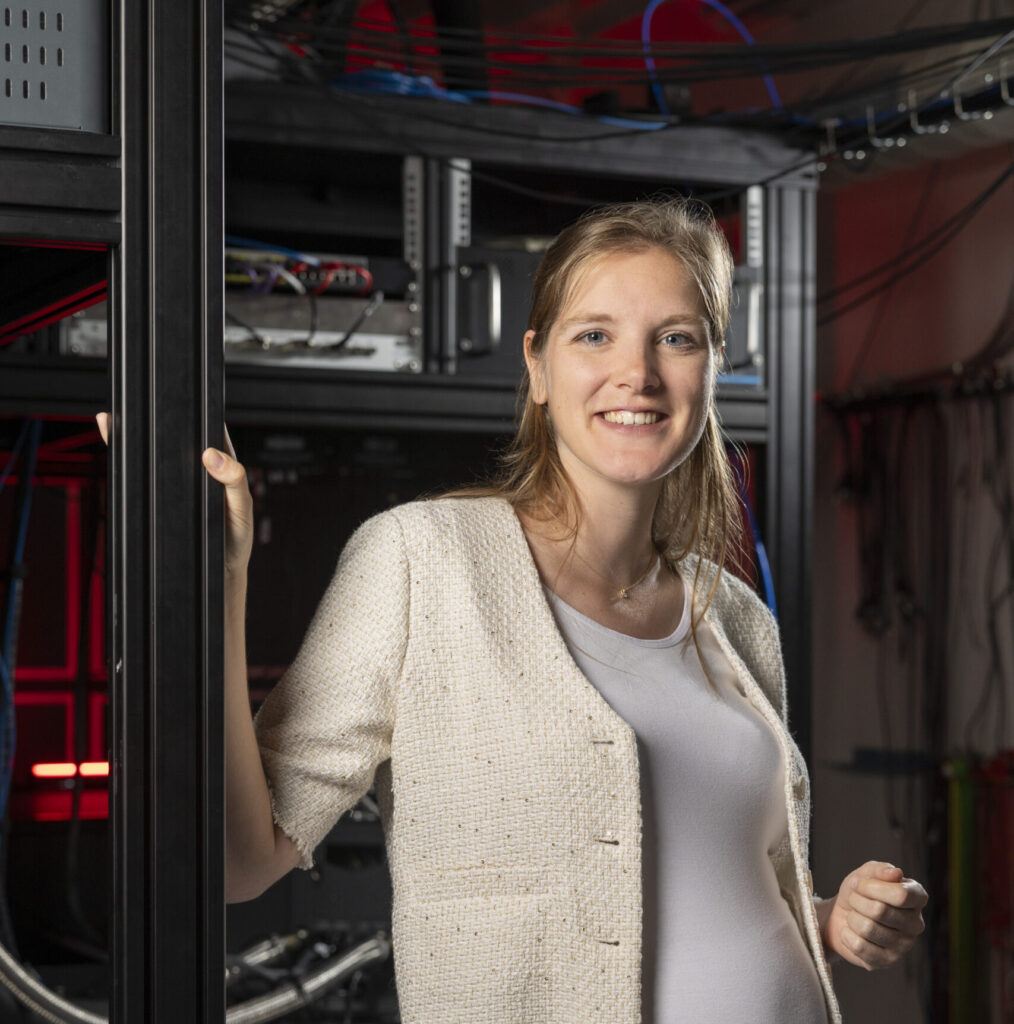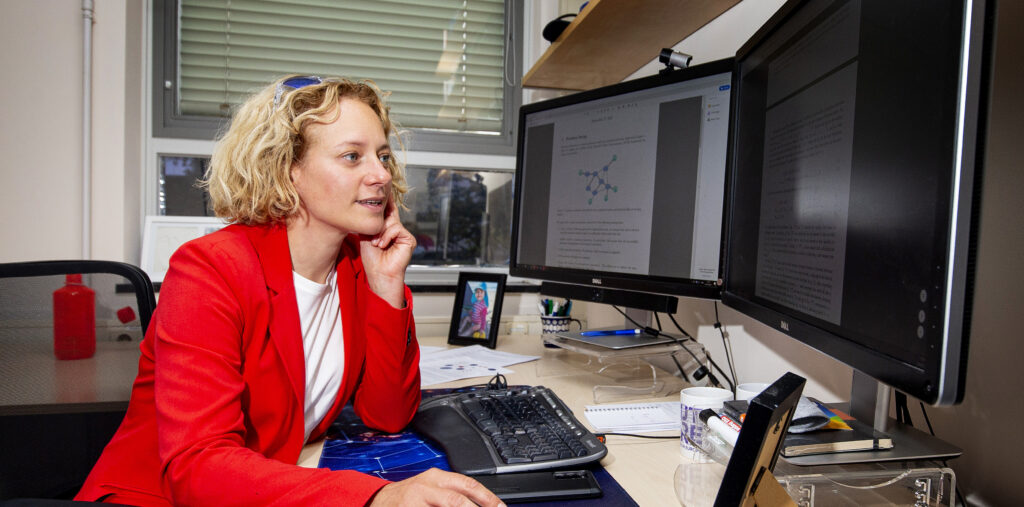Stories of Quantum
From Lockers to Networks: Quantum Networking with Rare-Earth Ions

Could tiny rare-earth ions, buried deep in crystals, reshape the very way we connect and communicate? That’s what Sophie Hermans is determined to find out. After a postdoctoral journey at the California Institute of Technology (Caltech), Hermans is now back at QuTech to start a new chapter: one that might unlock the potential of the quantum internet, which might change our lives as much as the original internet did.
It doesn’t take long in a conversation for Sophie Hermans to get excited: “The work horses of my research, ‘Rare-Earth Ions’, are like quantum lockers – embedded deep inside crystals, holding quantum information incredibly steadily. They’re the perfect candidates for the qubits we need to scale up quantum networks.” A quantum internet is a network that transmits information using quantum bits (qubits), harnessing quantum principles like entanglement and superposition to give it radically new capabilities. Unlike classical internet, it can detect eavesdropping, offering fundamentally secure communication and authentication. It can distribute quantum computations over several locations and it will open up new use cases in science and metrology. In other words, a future quantum internet will fundamentally change the way we share sensitive information and data.
“It’s as if these ions were naturally designed to help us”
Elements such as erbium, europium, ytterbium, and neodymium, all rare-earth elements from the bottom of the periodic table, offer extraordinary properties that make them uniquely suited for quantum technologies. Shielded naturally by their atomic structure, the quantum states of these ions are well-protected from the environmental disturbances that usually cause quantum information to deteriorate. “It’s as if these ions were naturally designed to help us overcome what we call decoherence,” says Hermans, smiling at the fortunate alignment of physics and practicality.
This decoherence, or deterioration of quantum information, is precisely the key issue in building a large-scale quantum network. While in classical networks the information can be copied and amplified, due to the quantum nature of qubits, lost quantum information is truly lost. This makes it difficult to scale up the number of connections in the network and to maintain these connections for a long time. Hermans’s research aims to tackle exactly that. “Stable qubits mean more robust connections and a reliable network,” she explains. “And a reliable network is the foundation for everything: from fundamentally secure communication to distributed quantum computing.”
“Stable qubits mean more robust connections and a reliable network – the foundation for everything.”
Yet the true beauty of using rare-earth ions lies in their flexibility. By embedding them into tailor-made crystal structures and various materials, Hermans envisions each node in a quantum network optimized for its precise function. ” This design flexibility provides a conceptual shift in the way we build the hardware for quantum networks. We don’t have to rely on a one-size-fits-all solution” she says. “We can design each node specifically—whether it’s routes connections in the network, interfaces with quantum processors, or deals with communication over vast distances.”
Her excitement for practical applications never diminishes her love for fundamental physics. “To engineer anything new and meaningful in this field,” she says thoughtfully, “we must first deeply understand the physics behind it. Every practical innovation begins with curiosity-driven questions: How does light interact with these rare-earth ions? Why do some crystal structures protect quantum information better? These answers hold the keys to practical breakthroughs.”

Sophie Hermans in the lab. Photo credit: Studio Oostrum for QuTech.
Back at QuTech, Hermans is building a research team grounded in collaboration. “This work can only move forward through teamwork,” she explains. “In the lab, progress depends on colleagues combining their skills and supporting one another. At the same time, working with other scientists nationally and internationally ensures that knowledge is shared and advances are made more efficiently. And beyond the scientific community, maintaining dialogue with companies and governments is essential to align efforts and make sure that quantum networks can develop to their full potential.”
“Quantum technology must belong to everyone, not just a select few.”
This brings her to another aspect close to Hermans’s heart: ensuring that the quantum future remains accessible and democratic. “Quantum technology must belong to everyone, not just a select few,” she emphasizes. It’s part of what drew her back to QuTech, an institute she admires for its inclusive and open philosophy. This commitment is also what drives her extensive efforts in science communication, ranging from informing legislators to appearances in (inter)national media and inspiring high school students. “Quantum computing and quantum networks will affect all our lives profoundly. It’s crucial that people become intuitively comfortable with what these technologies can and cannot do, without having to become a quantum physicist. Everyone deserves to understand and benefit from the quantum future we’re building together.”



